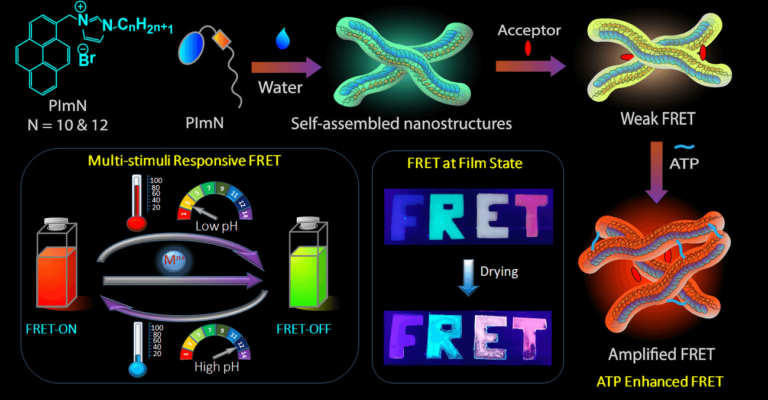Advanced ATP-Boosted Light-Harvesting: Water & Solid Magic
Work done in the lab of Dr. Supratim Banerjee at Indian Institute of Science Education and Research Kolkata.
Rakesh Biswas was born in Baduria, North 24 Parganas (West Bengal), India in 1992. He received the Bachelor of Science (B. Sc.) degree in Chemistry (honors) from Habra Shree Chaitanya College (in 2014) and Master of Science (M. Sc.) degree in Chemistry (with organic chemistry specialization) from Bidhannagar College (in 2016) under West Bengal State University. To inculcate his interest in interdisciplinary areas of research, he joined the Department of Chemical Sciences at the Indian Institute of Science Education and Research Kolkata (IISER-Kolkata) under the supervision of Dr. Supratim Banerjee’s Lab as a junior research fellow in January 2017 and completed the program of Ph.D. degree at July, 2023. He worked on various research topics including the application of supramolecular polymer in the aqueous media, detection of important bio-analytes through multivalent probes, aqueous-based host-guest chemistry, room temperature phosphorescence, artificial light-harvesting utilizing organic amphiphiles, etc.
Author Interview
How would you explain your research outcomes to the non-scientific community?
Photosynthesis is a fascinating natural phenomenon in which the energy of sunlight is absorbed by the densely packed chromophores in leaves and this energy subsequently migrates to the reaction centers through highly efficient energy transfer steps. Essentially, the absorbed energy is funneled to the energy acceptors which eventually transform the light energy into chemical energy. Inspired by this energy transfer process in photosynthesis, we have designed chromophore appended non-toxic organic amphiphiles (possessing both polar and non-polar parts) as energy donors and Nile red, an organic dye, as an energy acceptor for the construction of artificial energy transfer systems in the presence of adenosine triphosphate (ATP). Pyrene-tagged cationic amphiphiles formed self-assembled nanofibers in aqueous media which in the presence of ATP led to the fabrication of a supramolecular network (termed co-assemblies) through electrostatic interactions. The pyrene chromophores integrated into these interconnected nanofibers functioned as energy donors under UV light irradiation (used in the currency checking machine) and exhibited energy migration in the presence of a minimal amount of energy acceptor (~ 1 mol% Nile red) with close to 95% efficiency following a process known as Förster resonance energy transfer (FRET) mechanism. With a simple variation of donor and acceptor ratio, we successfully generated multi-color luminescent materials (blue-to-red) in the solution, solid and polymer films. A drastic change in the luminescence of the co-assemblies from red-to-green with increasing temperature and lowering pH of the medium also suggested their utilization as temperature thermometer and pH scale in both solution and solid states. Moreover, the ATP-based co-assemblies exhibited outstanding multi-stimuli responsive property which was further utilized in the security application. These supramolecular systems exhibited excellent energy transfer performance in both solution as well as solid states, suggesting their ability to be used in solar cell applications.

“The energy transfer systems exhibited a multi-stimuli-responsive nature which was employed for encryption-decryption applications.”
How do these findings contribute to your research area?
In the field of light-harvesting applications our result is the first report in which ATP-based assemblies were employed to fabricate artificial energy transfer systems with multi-stimuli responsive properties in the aqueous medium, solid state, and polymer films. Researchers have used ATP to construct dynamic and stimuli-responsive assemblies. We have utilized ATP as a polyanion for the fabrication of an interconnected supramolecular network which acts as an antenna of chromophores and efficiently transferred energy to the acceptor dye (Nile red) leading to the generation of multi-color luminescence (almost covering the whole range of the visible spectrum) in both solution and solid state. The energy transfer systems also exhibited a multi-stimuli-responsive nature which was employed for encryption-decryption applications.
What was the exciting moment during your research?
In my research career, understanding the changes in the photophysical properties of the organic amphiphiles in their self-assembled aggregates and the application of those aggregates for the detection of bio-analytes and the construction of light-harvesting antenna for energy transfer purposes was the most exciting moment for me.
What do you hope to do next?
As a future project, I want to really transform light energy into chemical energy through the utilization of the energy of light-harvesting processes as photocatalysts and their storage in the solar application.
Where do you seek scientific inspiration from?
I have been inspired to pursue science while visiting the hospitals. I have understood that doctors are the real savior for sick people but scientists can provide them with the essential drugs as a weapon to save life. I am really grateful to my Ph.D. supervisor Dr. Supratim Banerjee for teaching me the way of doing science and his guidance helped me enormously in learning many aspects of supramolecular chemistry.
How do you intend to help Indian science improve?
As a researcher, I believe the Indian scientists can produce enormous applications of science in various fields if good infrastructure is available. I will try to pursue academic and research to contribute new applications of science in biomedical research.
Reference: R. Biswas and S. Banerjee, ATP-Enhanced Multistimuli-Responsive Förster Resonance Energy Transfer in Organic Coassemblies, ACS Appl. Mater. Interfaces, 2023, 15, 24713−24723. (DOI: 10.1021/acsami.3c02018). https://pubs.acs.org/doi/10.1021/acsami.3c02018
Edited by: Nikita Nimbark
Biopatrika: Bringing Science to Society
© Biopatrika 2023 All Rights Reserved.

